|

by Daniel V. Boudillion
August 2002
Revised & Updated June 2003
from
Boudillion Website
Introduction
The purpose of this report is to draw attention to similarities
between a circa 1600 Indian Thunderbird artifact, and the
descriptions of an anomalous and frightening figure seen repeatedly
in 1967, dubbed "The Mothman."
Mothman
History
The Mothman is one of the strangest and most terrifying of
anomalous creatures ever to be recorded in America. Between November
12, 1966 and December 15, 1967, it terrorized citizens in the Point
Pleasant area of West Virginia. It was said to have been encountered
by at least 100 people over the course of that year.
According to author John A. Keel (The
Mothman Prophecies, 1975) who was on hand investigating
the reports during the time of the sightings, the creature was
reported to be roughly man-shaped, either grey or brown, and between
five and seven feet tall. Its body was wider than a man's. It did
not appear to have a head, but rather its "eyes" were set on the
upper chest. These "eyes" were very large, and alternately described
as glowing red lights, or a reflected red like a bicycle reflector.
(Glowing red eyes are the surest sign of a paranormal entity.)
When it walked it shuffled on what
appeared to be human-like legs, but no feet were ever observed.
Rather than arms it had bat-like wings which it did not flap. It was
always seen to glide. The non-flapping of the wings, even in ascent,
is particularly disturbing. Indeed, it was reported to regularly
ascend straight up like a helicopter - and again be it noted,
without any wing-action. (In regards to the wings, John Keel
determined that a man the size and heft of the Mothman would require
24 foot wings to be able to glide.)
It was fast in flight, able to pace cars
going over 100 miles an hour. In flight it emitted a humming sound
and often emitted a "mouse-like squeaking." Occasionally it was
heard to also emit a screeching sound something like a woman
screaming. (This "woman screaming" sound is common among
anomalous creatures, particularly the Bigfoot creatures.)
No one who saw it was indifferent to the
creature - it struck terror into the hearts of all its viewers.
Recently, interest in Mothman has been rekindled due to the release
of the movie The Mothman Prophecies starring Richard Gere.
Cryptozoologist Loren Colman has also contributed a new book
on the subject:
Mothman & Other Curious Encounters
(2002).
For comprehensive accounts of the Point
Pleasant/Mothman events, please refer to links such as:
prairieghosts.com, and
mothmanlives.com.
Thunderbird
Artifact
On June 15, 2002 I was visiting the Fruitlands Museum in
Harvard Massachusetts. While in the Indian Museum, I noticed an
artifact that bore a startling resemblance to Mothman descriptions.
This artifact is ten inches tall and made of copper sheet. It was
recovered in Amoskeag Falls, Manchester, New Hampshire, and was
probably fashioned from a copper kettle acquired through trade with
Europeans during the early Contact Period, circa 1550-1630 A.D.
It is attributed to the Pennacook
Indians and labeled "Thunderbird."
The main difference between the Mothman descriptions and the
Thunderbird artifact is that the artifact is crafted with a head,
while the Mothman is typically described as having no head.
The general body shape - other then the head discrepancy - is
identical. The most striking similarity is the "eye" placement. The
Thunderbird artifact has two holes placed on the upper chest, same
as Mothman descriptions.
Presently, these "eyes" on the
Thunderbird artifact are being used as string holes to lace the
figure to a museum stand. I inquired of the Museum Staff if the
holes were meant as "eyes", or were lacing holes. They did not know,
but gave their opinion that as "eyes", they were very compelling. I
also asked if the holes were part of the original creation or were
added later as lacing holes, but the staff was unable to provide
information on this.
A New England Koasek Abenaki who is familiar with both this item and
with Thunderbird lore states that,
"the two holes bored into the copper
at the 'chest' would have had a braintan lace knotted through
them to suspend the ornament/talisman from the wearer's neck."
He goes on to state that,
"We have our own theories as to the
significance...."
Interestingly, the Fruitlands item I
examined is only a reproduction - the original is in the collection
of the Peabody Museum at Harvard, catalog number 88-45-10/46959.
A Native American version of its
acquisition by Harvard's Peabody Museum is that it was obtained from
a robber of a Pennacook Abenaki gravesite in New Hampshire.
Comparison
Loren Coleman, in his recent book
Mothman & Other Curious Encounters,
created a composite sketch of the Mothman based on the various
reports and eyewitness testimony.
A written composite of the Mothman was
first published in 1970 in
The Complete Guide to Mysterious Beings
by John Keel - and an artists rendering of a sketch drawn by
Roger Scarberry who saw the the creature on November 15, 1966
first appeared in Janet and Colin Bord's 1981 book Alien Animals.
The Loren Coleman sketch is below left. To the right is a scan of
the Thunderbird artifact from the book The New England Indians
by C. Keith Wilbur.
It may also be found in The Western
Abenaki by Colin Calloway.
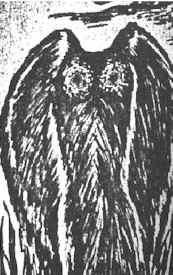 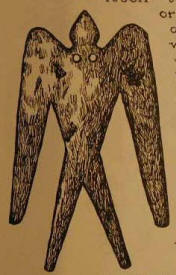
Thunderbird
Lore
Although primarily associated with the Plains Indians, the
Thunderbird was known to the Algonquin speaking peoples of New
England. However, like most Native American culture in New England,
little is now known of their beliefs.
In regards to the Thunderbird, this much
is known:
it was a fearsome being and
resembled a winged man or an immense bird, it caused fear and
dread, and was said to actually kill and eat humans from time to
time.
(Jim Brandon - The Rebirth Of
Pan)
Pmola
According to a New England Koasek Abenaki about the Pmola (puh-MOH-lah):
"Our legends tell us of a being
who appeared as a giant bird-like creature, with glowing red
eyes and claws, who would swoop down on unsuspecting animals
and people and carry them off ... never to be seen again.
The Indian peoples of the
Eastern Seaboard and Woodlands all share similar stories.
Grandmothers and Mothers would caution their children to
behave, lest Pmola find them unawares and carry them away."
Piasa
Jacques Marquette, a French explorer relates a petroglyph
of the Piasa near Alton Illinois in 1673:
"On the flat face of a high rock
were painted, in red, black, and green, a pair of monsters,
each as large as a calf, with horns like a deer, red eyes, a
beard like a tiger, and a frightful expression of
countenance.
The face is something like that
of a man, the body covered with scales, and the tail so long
that it passes entirely round the body, over the head, and
between the legs, ending like that of a fish." It was
supposed to live high in a cave on the bluff.
An Alton, Illinois scholar named McAdmas observed during the
mid 1800s, that the name Piasa "signifies, in Illini, 'The
bird that devours men.'"
And indeed, it was Illini legend
that children and adults were carried away and eaten.
Tlanuwa
The Cherokee ledged of the Tlanuwa is similar of the Piasa. The
Tlanuwa were a pair of immense birds said to live in a cave on
the north bank of the Little Tennessee River in Blount County
Tennessee.
They would fly up an down the river,
even coming into the villages to carry off and eat dogs and
small children.
Bad8gi
According to a New England Koasek Abenaki about the Bad8gi (BAH-dohn-KEE):
"I personally believe that the
Thunderbird here in the East is based upon an ancient
species of raptor, one that possessed a wingspan in excess
of twenty feet. These gigantic preying birds were the
antecedents of the Eagles that are so important to our
culture and traditions today.
Ancient oral traditions among
the Algonquin/Abenaki tell us that these raptors rode the
lightning and the thunderheads, coming up from the South, in
a corridor that extends from Mexico right on up the
Appalachians into New Hampshire, Vermont and Maine. I
believe that the copper representation you refer to is this
Thunder Being, and was made to harness the spiritual powers
to benefit the wearer.
Our word for this Being
is Bad8gi."
[The "8"
in Bad8gi is intentional. In Abenaki, the sound "OOHN" is
represented by the 8 or ô, (an "o" with a circumflex.) ]
Giant Birds?
The largest bird in North America is the California Condor with a
wingspan of up to nine feet. The largest known bird today is the
Andean Condor with a wingspan up to 12 feet. Unlike the Andean
Condor, the California is a very rare and endangered bird with only
a small territory left of its once large range. But as recently as
the early 1800's it still apparently lived in eastern America as
well, according to Halliday's Vanishing Birds.
Could Andean Condors, however, be flying
up - or have ever flown up from South America? In any event,
Ornithologists tell us that the claw strength of either condor is
not strong enough to carry food for much distance, and besides, the
condor is a carrion eater, not a predator bird.
Be that as it may, reports of giant birds - Thunderbirds perhaps -
have been reported in eastern America since colonial times. These
giant birds are reported to have wings like a "B-29", and are known
for trying to carry off children and livestock. Numerous modern
reports from Illinois attest to this.
Interestingly, there once existed a gigantic bird in North America
called the Teratornis Merriami (Feduccia, The Age of Birds).
It stood five feet tall with a 24 foot wingspan.
According to Dr. Kenneth Campbell
it was, unlike the condor, a predator bird,
"the long narrow beak was of the
predator type, rather than the carrion eater type (condor)."
He goes on to say,
"the bones of some as recent as 8000
years ago have almost always been found in conjunction with
human habitation sites."
(Loren Coleman comments: "Were
Amerindians killing these giant condor-like birds for their
feathers or because the birds had been kidnapping their children
and stock?")
This is interesting information indeed,
because 8000 years places it well within the human era, and
Thunderbird legends may well be echoes of this giant predator
bird.
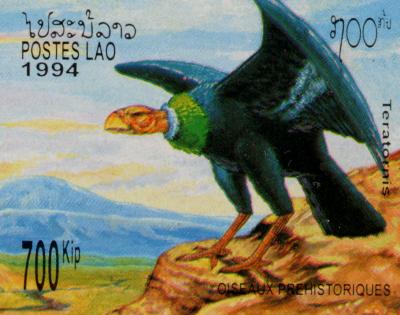
Teratornis Merriami
Native Americans who have written me
have this to say about the Giant Bird/Thunderbird connection:
"The giant raptors were strong
fliers and strong walkers. They preferred making short trips on
foot and they were the size of a man and walked almost erect
(not like the usual bird). Indians in Illinois dreaded meeting
the giant raptor at night and mistaking it for a human, which
happened."
From another source,
"[Consider] Nadinahamasit,
the Turkey Vulture. If you have ever seen this unmistakable form
above you, it is real easy to visualize the Thunderbird. Black,
all wings and primaries outstretched, just a ridin'-the-thermals,
little no-neck head darting this way and that, looking for
prey."

Turkey Vulture
These descriptions are particularly
relevant as the silhouette of a giant walking turkey vulture
(if there is such a thing) would from behind have a very similar
silhouette to the Mothman, and, it is interesting to note that the
Mothman is described as "... from behind, it appears to have no
head."
Bearing in mind Loren Coleman's remark, a correspondent had this to
say,
"My father's grandmother was one of
the last Tamaroa Indians, who were natives of central Illinois
along the Mississippi river and its tributaries. According to
them, they battled the giant eagles for generations and when the
last one known to them was finally killed they found hundreds of
human skulls in its lair. It was not a condor or vulture but a
perfect replica of the familiar golden eagle but about 3 times
larger. Despite their size they were strong fliers and also
strong walkers, and they preferred to traverse short distances
afoot walking almost erect like a human with folded wings behind
them."
Paranormal Aspects
Giant bird sightings are not, however, in any way straightforward -
if that can even be the case in such an odd subject. There is a
certain paranormal element to many of the modern sightings.
For example, in Illinois - which is a hot-spot of such sightings -
reports are that the creatures glow.
Typical of night sightings,
"It was grayish and illuminated ...
it as big as a house. It [glowed] greenish-yellow and bobbed up
and down."
Another report, "[it was] illuminated by
a dull glow."
And,
"Its eyes were wide open and shone
like burning coals."
(All from Alton Illinois - Piasa
territory.)
Mothman's European
Relatives
The Mothman and his kin seem to get around. The following are
reports of winged "human-shaped" entity sightings.
-
Sweden, 1946: During the "ghost
rocket" episode, the Swedes were also reporting huge winged
creatures without heads.
-
Kent England 1963: Four teenagers
saw a black figure shuffle towards them, "It was the size of a
human ... but it didn't seem to have any head ... there were
huge wings on it back - like bat wings." (Mervyn Hutchinson)
-
Mawnan Cornwall, 1976: Two 14 year
old girls and a 12 year old saw a hissing "owl man" accompanied
by a hissing noise.
-
Sally Chapman: "It was like a
big owl with pointed ears, as big as a man. The eyes were
red and glowing ... its feet were like pincers."
-
Barbara Perry: "It was horrible,
a nasty owl-face with big ears and big red eyes. It was
covered with grey feathers. The claws in its feet were
black. It flew straight up...."
(See June Mellings sketch
below.)
Note the headlessness in the
Swedish and English accounts, and the glowing red eyes,
grey feathers, and ability to fly straight up on the
Cornwall accounts. All are reported attributes of the American
Mothman.
The grey feathers, the shuffle-walk, and
the red eyes are shared by both the Mothman and the
Thunderbird.
Assessment
There is a startling visual resemblance
between the Mothman descriptions and the Thunderbird artifact. The
single difference is the head - the Thunderbird has one, Mothman
doesn't. If the holes in the Thunderbird figure were intended as
eyes, the identical placement of the eyes is a significant feature.
With the exception of the head, the Thunderbird is a figure that
exactly reproduces the Mothman descriptions.
A correspondent has this to say about the head-discrepancy:
"I feel compelled to tell you that I
found an important misconception in your evaluation of the
Pennacook figure. The shape in the Native America figure is not
a "head", but a stylized flame as shown by it's shape. This has
been placed there to anthropomorphize the figure but does not
show a solid head. This in my eyes makes the figures identical."
(While on the subject of heads, it is
interesting to note that in 1952 in Flatwoods West Virginia a
towering entity with glowing eyes and a "head shaped like an ace of
spades" was seen by multiple witnesses. The "ace of spades" shape is
a good description of the head on the Pennacook Thunderbird
artifact.)
A second resemblance is its perceived disposition: the citizens of
Point Pleasant felt terrorized by the Mothman - the Thunderbird was
a figure of dread and fear in the culture of the Pennacook craftsman
who created the copper figure.
There is more correspondence between the artifact and composite
sketch than between physical descriptions of the Mothman and
traditional descriptions of the Thunderbird. The traditional
descriptions of the Thunderbird tend to represent a
gigantic bird, while the Mothman is described as a
winged man-like figure.
However, in either case, both had glowing red eyes - a
telling clue - and flew, and were beings of dread. From behind, a
large walking Thunderbird bird would resemble a Mothman being. The
oddly raised shoulders of the Mothman would correspond to the
hunched up wings of a shuffling bird. Both are recorded as
shuffling.
It is also significant that Thunderbird
lore states that giant raptors when walking could be mistaken at
night for a human.
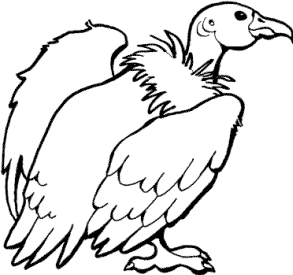 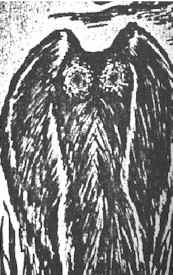
Wings hunched up into
points resembles Mothman shoulders
Interestingly, both the Mothman
and Thunderbird are recorded as flying without flapping their
wings. The Mothman is always recorded this way, the Thunderbird only
occasionally.
However, the occasions it is sighted in
"paranormal" non-flapping flight, are also the occasions it is
observed to have
glowing red eyes.
Conclusions
The Pennacook Abenaki Thunderbird artifact has been labeled a
"Bad8gi" Thunder Being by the modern Koasek Abenaki. The "Mothman"
sketch is a composite of over 100 witness accounts from 1966. Both
items are visually similar, and significant portions of their lore -
the paranormal portions - overlap. One assumes there is a
connection, a commonalty.
But are they the same being?
 
The initial question may not be whether
there is a strange "Mothman" creature that troubled folks in West
Virginia, or whether there really is or was a Thunderbird being that
the Pennacook of New Hampshire and other Algonquin speaking tribes
of New England feared - the point is that both cultures have legend
of it, and images of this creature (in this case composite sketch
and copper artifact) - with the exception of the head motif in this
instance - are identical.
Secondly, it would appear that this is a case of significant
correspondence between anomalous-appearing beings, rather than
sightings of a real yet unknown species (such as a large bird). The
constants between the Mothman and Thunderbird are in
the paranormal aspects. If they are the same creature, they are a
paranormal one.
Thirdly, in regards to the Thunderbird, there appears to be two
situations happening simultaneously: a paranormal red-eyed anomalous
entity, and the possibility of a large unknown raptor akin to the
Teratornis Merriami. This does not apply to the Mothman or his
kin - the Mothman has always proved himself to be paranormal.
If there are indeed strange paranormal beings in the world,
perhaps they are definable by types - much in the way the reports of
lake monsters and Bigfoot are recognizable "types." If so, whatever
produces these phenomena appears to be consistent in its types. I
find it curious that two cultures separated by 400 years, 750 miles,
and dissimilar cultures have recorded a particular "type" in almost
exact detail.
I would say that there are grounds for suggesting that the good
folks at Point Pleasant in 1966 and the fine Abenaki
Pennacook of sixteenth century New Hampshire were reporting
images of the same being - whatever that being may really be.
Anyone who would like to correspond about possible Mothman and
Thunderbird connections, or has further information, may do so at:
dvb@boudillion.com.
Notes &
Sources
-
Alien Animals by Janet and Colin
Bord
-
Complete Guide to Mysterious
Beings by John Keel
-
Curious Encounters by Loren
Coleman
-
Goblin Universe by Ted Holliday
-
Mothman & Other Curious
Encounters by Loren Coleman
-
Mothman Prophecies by John
Keel
-
Mysterious America revised
edition by Loran Coleman
|
Written Sketch of Mothman
by John Keel
Compiled by more than 100
eyewitness accounts
-
Height: Between
five and seven feet tall. Usually described as
"taller than a good-sized man."
-
Breadth: Broad at
the top with a slight taper downwards. Always
described as "very broad, much broader than a man."
-
Covering:
Witnesses have been unable to determine if it is
clothed or covered in skin. Generally described as
being grey, though some thought it was brown, One
witness thought it was covered with grey fur.
Daylight sightings by others do not substantiate
this.
-
Head: Seen from
the back it appears to have no head. Few witnesses
reported seeing any face at all.
-
Eyes:
Self-luminous, bright red, approximately two to
three inches in diameter, set wide apart. Witnesses
say the eyes are set in near the top of the
shoulders.
-
Legs: Man-like.
No witness has ever been able to describe the feet.
-
Arms: None. No
witness has ever reported seeing arms.
-
Wings: Folded
against the back when not in use. Wingspread,
everyone agrees, is about ten feet. Bat-like. Do not
flap in flight.
-
Carriage: Animal
walks erect like a man. Does not stoop like a bear
or ape. Moves its legs in shuffling manner. Some
said it "waddled."
-
Sound: Loud
squeaks, like a mouse. One witness said it sounded
"like a squeaky fan belt." Two witnesses testified
they heard a mechanical humming sound as the
creature flew overhead.
-
Speed: It is said
to have kept pace with automobiles moving seventy to
one hundred mph. Few birds can achieve this in level
flight. Pilot witnesses estimated it was traveling
at least seventy mph in level flight without
flapping its wings.
|
June Melling's sketch of Cornish Owl
Man:
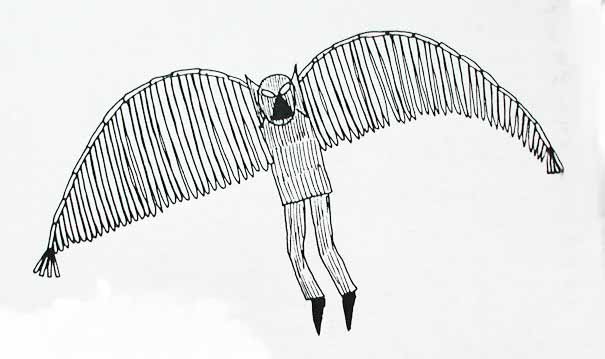
Cornish Owl Man - Melling Sketch
Note: the eyes and head set down in the
shoulders creates the
same "headless red-eyed" silhouette as the Mothman.
Artists rendering of Roger Scarberry's 1966
Mothman sketch:
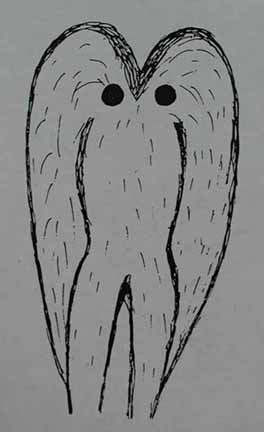
Mothman
- Scarberry Sketch
Addendum - The Red Eye
Gallery
A consistently reported feature of paranormal creatures are their
glowing red eyes. Both the Mothman and many of the
Thunderbird sightings include this anomaly in the reports. No
known terrestrial birds or beasts have self-luminous eyes. Some
animals, particularly the nocturnal ones, have reflective eyes -
their eyes have a mirror quality that helps make the most of the
available light.
But this reflection is silver-white, and
does not glow, let alone glow red. Where eyes glow red, the
paranormal is close at hand. It is one of the surest signs of the
paranormal in a sighting.
Below are the sketches of the Mothman, and the Thunderbird artifact,
with the eyes filled in red for side-by-side comparison.
Please note also that the Owl Man's head and eyes are set down low
on the shoulders - so low that in the dark or from behind it would
present the same "headless, glowing-eyes-on-the-chest" appearance
and silhouette of the Mothman.
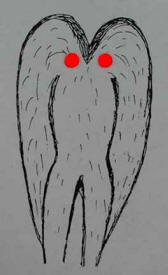 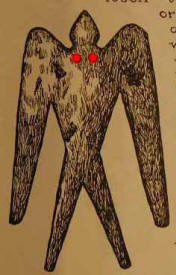 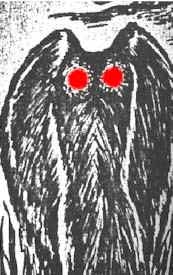
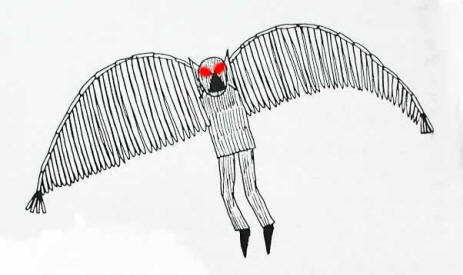
"The chlorine in the
pool is killer!"
|












